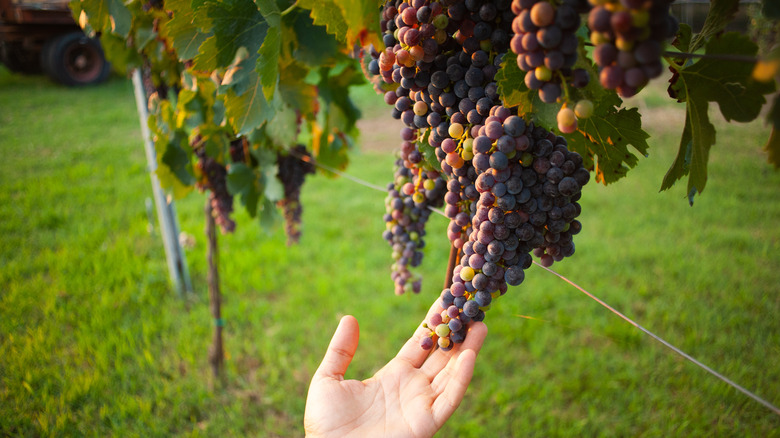Why Some Modern Vineyards Use Cow Skulls In The Soil
The distinction between a crop and final product can be minimal, or it can be a full transformation. When it comes to wine, it's remarkable that grapes on vines transform into an alcoholic beverage that comes in a range of flavors and colors. While some of the processes used in vineyards and wineries are highly mechanized and dare we say, chemical, others are just plain quirky.
Many consumers would think a winegrower was joking if they described burying cow skulls in their vineyard soils. In a list of facts you might not know about wine, Mental Floss explains that some present-day vineyards employ this practice. It isn't a widespread phenomenon, but it is an element of biodynamic vineyards, a specialized subset of winemaking. Although a farmer burying an animal skull could be misconstrued as a form of witchery, there are legitimate reasons why a farmer might use the procedure. For starters, a direct comparison can be made with composting. Biodynamic preparations are broken down into two main categories: compost and spray (via Demeter).
Before digging deeper, let's take a closer look at what biodynamic farming entails. According to Demeter, the international certifying federation for biodynamics, it's a method of sustainable agriculture that was originally developed by philosopher Rudolph Steiner in 1924. Steiner believed that the ultimate goal in agriculture was to develop farms that subsisted as "self-contained entities". To achieve this, he created procedures to increase soil fertility, disease resistance, and the overall well-being of the land.
Does it work?
BioLOGIC explains that "preparation 505" entails stuffing an animal skull (cow, goat, or sheep) with oak bark to promote calcium balance in the soil. Next, the preparation is composted in the soil near a source of water in the fall and dug up in the spring. As with most biodynamic farming, the seasonal flux and moon cycles are relevant in determining the timing of the agricultural activity (via Biodynamic Association). Steiner's reasoning behind preparation 505 may appear fairly convoluted to the average person, but the biodynamic wine market has ardent supporters.
VinePair indicates that there is no evidence that someone could differentiate a biodynamic wine in a blind tasting scenario. However, the meticulous care in the vineyard likely enhances the sensory qualities to some extent. In fact, a study published in 1995 in the American Journal of Alternative Agriculture recognized better soil quality in biodynamic farms. VinePair estimates that around 700 producers worldwide practice these holistic farming methods. Not all biodynamic vineyards choose to be certified by Demeter, and Vitis Magazine indicates that organic certification is generally a prerequisite.
While "biodynamic" and "organic" refer to a distinct set of criteria, it would be hard to practice biodynamics while simultaneously spraying chemical pesticides and fertilizers on your vineyards. You might not be able to taste evidence of biodynamic farming (which is good if we're talking about cow skulls), but there's no doubt that greater care in the vineyard leads to a higher quality product.

